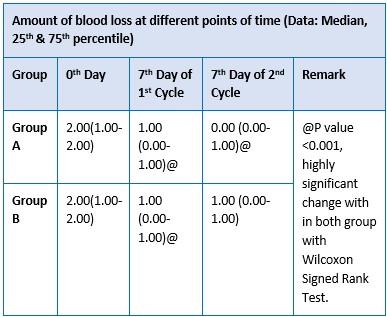The effect of Bhumyamalaki Churna and Kusha Mula Churna in the management of Asrigdara w.s.r. to Menorrhagia
DOI:
https://doi.org/10.21760/jaims.8.9.6Keywords:
Asrigdara, Menorrhagia, Pradara, Rajaswala Paricharya, Sutika ParicharyaAbstract
Background: Now a days in fast developing globalized era, the percentage of working women are more. Due to the busy schedule, she is unable to follow Paricharyas as mentioned in Samhitha, such as Rajaswala Paricharya, Sutika Paricharya. Due to which women are prone for menstrual disorders. One fifth of the women have the problem with heavy menstrual blood loss at some period of their reproductive life. One among them is Menorrhagia. Prolonged bleeding causes psychological upset like discomfort during work, lack of concentration, mental disturbance etc. Menorrhagia is defined as cyclic bleeding at normal interval; the bleeding is either excessive in amount (>80ml) or duration (>7days) or both. Menorrhagia is largely responsible for iron deficiency and iron deficiency anaemia, both of which have negative effect on women health. Acharyas explained both Shamana Chikitsa and Shodhana Chikitsa for Asrugdara. Among Shamana Chikitsa Bhumyamalaki Churna and Kusha Mula Churna are mentioned by Bhaishajya Ratnavali and Chakradatta respectively. Bhumyamalaki and Kusha Mula have Kashaya and Madhura Rasa, Shita Virya and Madhura Vipaka, does Pitta Shamana and Stambhana Karma. Both the drugs are easily available hence are opted for the study. Materials and methods: The present study was Randomised clinical study where 30 subjects diagnosed with Asrugdara was taken in 2 groups with 15 subjects in each group. Conclusion: Bhumyamalaki Churna is found to be more effective in managing the Asrugdara w.s.r. Menorrhagia.
Downloads
References
Dutta D C. Textbook of Genecology. Edition 8, New Delhi: Jaypee Brothers; 2020.p.156.
Dutta D C. Textbook of Genecology. Edition 8, New Delhi: Jaypee Brothers; 2020.p.156-164.
Kotagasti T. Prevalence of different menstrual irregularities in women with abnormal uterine bleeding (AUB)-an observational study. International Journal of Current Research and Review. 2015 May 15;7(10):66.
Harischandra singh Kushwaha, Charaka Samhita of Agnivesha, Vimana Sthana. Ayushi Hindi commentary Ch. 28, ver. 11. Varanasi: Choukambha Orientalia; 2005. p.475.
Tiwari P V. Ayurvediya Prasooti Tantra evam Stree Roga. Edition 2. Vol.2, Varanasi: Chaukambha Orientalia; 2017.p. 180.
Shastry J L N. Dravya guna Vignana. Volume II. Varanasi: Chaukamba Orientalia; 2010.p.930.
Shastry J L N. Dravya guna Vignana. Volume II. Varanasi: Chaukamba Orientalia; 2010.p.1028.
Kiemer AK, Hartung T, Huber C, Vollmar AM. Phyllanthus amarus has anti- inflammatory potential by inhibition of iNOS, COX-2, and cytokines via the NF-κB pathway. Journal of Hepatology. 2003 Mar 1;38(3):289-97.
Joseph B, Raj SJ. An Overview: Pharmocognostic property of Phyllanthus amarus linn. International journal of Pharmacology. 2011;1:41.
Vithalrao Bhimashya Khyade. Novel Sacrificial Medicinal Repositories Haf grass, Demostachya bipinnata(L.)and Cogan grass, Imperata cylindrica(L.). WSN. 2018:35-50.
Himamshi V. Role of Darvyadi Ghana Vati in the Management of Asrugdhara, MS [Dissertation]. Jamnagar, Gujarat Ayurveda University; 2006.















